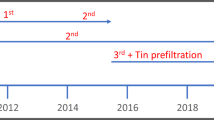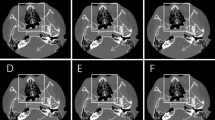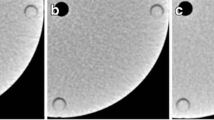Abstract
Objective
To evaluate the clinical application of a full model-based iterative reconstruction (MBIR) algorithm in the ultra-low-dose paranasal sinus CT imaging of children.
Materials and methods
In the first phase, 16 low-dose CT dacryocystography (DCG) (80 kV/64 mAs) scans were reconstructed with MBIR and filtered back-projection (FBP) to demonstrate noise reduction capability of MBIR. MBIR images were also compared with the images of 21 standard-dose paranasal sinus patients reconstructed with adaptive statistical iterative reconstruction (ASIR) algorithm. In the second phase, 14 pediatric tumors patients (images with ASIR in the initial scan) who came for follow-up paranasal sinus CT scan were prospectively enrolled with reduced radiation and MBIR algorithm. In both study phases, image noise and the contrast noise ratio (CNR) of sphenoid was measured; and subjective image quality was evaluated. CTDIvol and DLP were recorded, and effective dose calculated.
Results
The CTDIvol value for the DCG group was 63.9% lower than the standard-dose sinus group (1.09 ± 0.01 mGy vs. 3.02 ± 0.35 mGy). Compared with the ASIR reconstruction in the standard-dose sinus patient group, images with MBIR in the ultra-low-dose DCG group had 39.9% lower noise (9.5 ± 0.8HU vs. 15.8 ± 3.3HU) and 63.6% higher CNR (14.4 ± 4.7 vs. 8.8 ± 2.2), with similar subjective image quality score. For the tumor patients, 65.5% dose reduction was achieved. Subjective quality scores were similar between the initial and follow-up scans. Objective noise was significantly lower for the follow-up group.
Conclusion
MBIR provided equal or better image quality with significantly reduced radiation dose in paranasal sinus CT imaging of pediatric patients compared with standard-dose CT with ASIR algorithm.


Similar content being viewed by others
References
Dammann F (2007) Imaging of paranasal sinuses today. Der Radiologe 576:578–583
Schell B, Bauer RW, Lehnert T et al (2011) Low-dose computed tomography of the paranasal sinus and facial skull using a high-pitch dual-source system-first clinical results. Eur Radiol 21:107–112
Schulz B, Potente S, Zangos S et al (2012) Ultra-low dose dual-source high-pitch computed tomography of the paranasal sinus: diagnostic sensitivity and radiation dose. Acta Radiol 53:435–440
Schulz B, Beeres M, Bodelle B et al (2013) Performance of iterative image reconstruction in CT of the paranasal sinuses: a phantom study. AJNR Am J Neuroradiol 34:1072–1076
Lam S, Bux S, Kumar G et al (2009) A comparison between low-dose and standard-dose non-contrasted multidetector CT scanning of the paranasal sinuses. Biomed Imaging Interv J 5:e13
Wuest W, May M, Saake M et al (2016) Low-Dose CT of the paranasal sinuses: minimizing X-Ray exposure with spectral shaping. Eur Radiol 26:4155–4161
Dauer LT, Ainsbury EA, Dynlacht J et al (2017) Guidance on radiation dose limits for the lens of the eye: overview of the recommendations in NCRP Commentary No. 26. Int J Radiat Biol 3:1–9
Lell MM, May MS, Brand M et al (2015) Imaging the parasinus region with a third-generation dual-source ct and the effect of tin filtration on image quality and radiation dose. AJNR Am J Neuroradiol 36:1225–1230
Niu Y, Wang Z, Liu Y et al (2010) Radiation dose to the lens using different temporal bone CT scanning protocols. AJNR Am J Neuroradiol 31:226–229
Funama Y, Awai K, Shimamura M et al (2005) Reduction of radiation dose at HRCT of the temporal bone in children. Radiat Med 23:578–583
Mills DM, Tsai S, Meyer DR et al (2006) Pediatric ophthalmic computed tomographic scanning and associated cancer risk. Am J Ophthalmol 142:1046–1053
May MS, Brand M, Lell MM et al (2017) Radiation dose reduction in parasinus CT by spectral shaping. Neuroradiology 59:169–176
Bulla S, Blanke P, Hassepass F et al (2012) Reducing the radiation dose for low-dose CT of the paranasal sinuses using iterative reconstruction: feasibility and image quality. Eur J Radiol 81:2246–2250
Gay F, Pavia Y, Pierrat N et al (2014) Dose reduction with adaptive statistical iterative reconstruction for paediatric CT: phantom study and clinical experience on chest and abdomen CT. Eur Radiol 24:102–111
Widmann G, Dalla Torre D, Hoermann R et al (2015) Ultralow-dose computed tomography imaging for surgery of midfacial and orbital fractures using ASIR and MBIR. Int J Oral Maxillofac Surg 44:441–446
Hoxworth JM, Lal D, Fletcher GP et al (2014) Radiation dose reduction in paranasal sinus CT using model-based iterative reconstruction. AJNR Am J Neuroradiol 35:644–649
Deak PD, Smal Y, Kalender WA (2010) Multisection CT protocols: sex- and age-specific conversion factors used to determine effective dose from dose to length product. Radiology 257:158–166
Aksoy EA, Ozden SU, Karaarslan E et al (2014) Reliability of high-pitch ultra-low-dose paranasal sinus computed tomography for evaluating paranasal sinus anatomy and sinus disease. J Craniofac Surg 25:1801–1804
Bodelle B, Wichmann JL, Klotz N et al (2015) Seventy kilovolt ultra-low dose CT of the paranasal sinus: first clinical results. Clin Radiol 70:711–715
Sun J, Peng Y, Duan X et al (2014) Image quality in children with low-radiation chest CT using adaptive statistical iterative reconstruction and model—based iterative reconstruction. PLoS ONE 9:e96045
Sun J, Zhang Q, Hu D et al (2015) Improving pulmonary vessel image quality with a full model-based iterative reconstruction algorithm in 80 kVp low-dose chest CT for pediatric patients aged 0–6 years. Acta Radiol 56:761–768
EC (2016) european guidelines on drls for paediatric imaging. iop publishing physicsweb. http://www.eurosafeimaging.org/wp/wp-content/uploads/2014/02/European-Guidelines-on-DRLs-for-Paediatric-Imaging_Revised_18-July-2016_clean.pdf
Acknowledgements
We are grateful to all subjects and their family members for their cooperation in providing clinical information for the study. We would like to express our sincere thanks to Dr. Jianying Li and Dr. Ning Guo for their technical support in understanding the model-based iterative reconstruction algorithm and in editing the manuscript.
Author information
Authors and Affiliations
Corresponding author
Ethics declarations
Funding
This study was supported by the Beijing Children’s Hospital Young Investigator Program (Grant Numbers BCH-YIPB-2016-06) and Clinical Technology Innovation Project of Beijing Municipal Commission (Grant Numbers xmlx201407).
Conflict of interest
The authors declare that they have no conflict of interest.
Ethical approval
The present study was approved by the Ethics Committee of Beijing Children’s Hospital. The legal guardian of all the children signed written informed consents.
Rights and permissions
About this article
Cite this article
Sun, J., Zhang, Q., Duan, X. et al. Application of a full model-based iterative reconstruction (MBIR) in 80 kVp ultra-low-dose paranasal sinus CT imaging of pediatric patients. Radiol med 123, 117–124 (2018). https://doi.org/10.1007/s11547-017-0812-0
Received:
Accepted:
Published:
Issue Date:
DOI: https://doi.org/10.1007/s11547-017-0812-0




